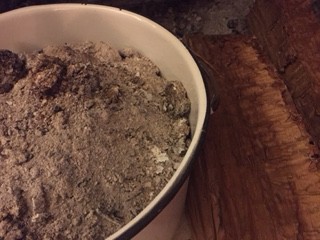10 Ways to Use Wood Ash on a Homestead

There’s nothing better on a cold winter’s day than a roaring fire. The warmth and ambiance fills the soul, not to mention warms it as well. I usually have a fire going from the time I get home from work until it’s time to turn in. The fire not only heats the house, but it also keeps the furnace from going on until it’s really needed. And, by that time I’m snug in a warm bed. So, the fireplace pulls double duty.
I get seasoned and split firewood from a local rancher who allows me to pick it up for free as long as I “pick it up”. No delivery service here. Not a bad deal and the exercise in the cool fall months is very energizing.
Our winters are not terribly cold here, so I only go through about 3-4 cords of wood. But, imagine 3 to 4 cords worth of fireplace ash! And, consider this…a cord of wood produces about 50 pounds of ash.
Yikes…what to do with all that ash???
Well—the good thing about natural wood and ash from the wood is that it’s considered a natural substance. When wood is burned it lets out nitrogen and sulfur as a gas, and what remains is magnesium, calcium, potassium and other trace elements. In fact, wood ash contains most of the 13 essential nutrients needed for soil to sustain plant growth. That’s right. Wood ash can be used as a soil conditioner, insect repellent, and fertilizer. It can even be used to make soap.
So—before you toss that ash into the trash bin check out these 10 uses around the homestead.
In The Garden
- Enrich Compost – Mix in about a cup of ash to a 4’x4’x4’ compost bin to enhance its nutrients. Or, calculate a cup per 64-cubic feet of raw compost materials. Don’t overdo it though. Ash is very alkaline and will throw off the Ph balance of your compost if you use too much.
- Use as a Pre-emergent – Sprinkle ash on the soil in winter or early spring, before plants emerge. If you add ash to areas where seeds or transplants will be planted, hold off planting for a few weeks. Also wait a few weeks to sprinkle around newly planted areas. The shock of the sudden increase in Ph could be too much for young plantings.
- Repel Slugs & Snails –Spread evenly around garden beds, on dirt paths, around berry patches and fruit trees to ward off slugs and snails. It’s caustic, so the slimy bugs won’t like it.
- Terrific Tomatoes – Make an ash tea to boost the potassium level of potassium loving tomatoes. Put 5 pounds of ash into a permeable cloth, like a burlap bag or an old t-shirt made into a bag. Tie it closed and lower the bag into a 50-gallon trashcan filled with water. Let it sit for about 4 days, then pour about a cup full on your tomatoes once a week.
- Feed your Lawn – Before a storm, lightly sprinkle ash on your lawn to provide extra nutrients. The rain water will help push the nutrients down to the roots, where they are needed.
The secret to using wood ash in the garden is to “dust it”, don’t “dump it”.
Around The Homestead
- De-skunk the Dog – If man’s best friend has tangled with a skunk, simply rub a handful of ash all over his body. The ash will naturalize the smell.
- De-Ice the Driveway – Ash won’t hurt the soil or cement so it can be used to melt ice, snow or provide traction where needed.
- Clean Sooty Windows – Use a damp sponge and dip into a pail of ash. The ash dust scrubs away soot and residue.
- Absorb Paint – Sprinkle ash onto an area where paint has been splattered and scuff with your boot to absorb and blend it in with the cement.
- Make Soap – Ashes can be made into lye by soaking them in water. Immerse the ashes in water and let them settle then skim off the lye from the top. You can do this every day until you have enough lye to make soap. The lye can be mixed with animal fat and then boiled to make soap.
Notes of Caution:
Before you launch off and clean out that wood stove or firebox there are a few tips to handling ash safely. First off, find yourself a sturdy metal trashcan with a lid, one that will be dedicated to hold only ash. Secondly, wait for the ash to cool completely before putting it in the trashcan. No warm or hot stuff. When cleaning out the firebox or stove use caution to not breathe in the ash dust or get it in your eyes, nose or mouth, it’s caustic. It’s best to wear protective gear when doing this. You know…goggles, gloves and mask. Better safe than sorry. Keep it stored in a safe place with the lid tightly fastened so a brisk wind won’t send the ash flying around the homestead for animals and humans to breathe.
I use a thrift store ash bucket to transfer ash from the fireplace to the larger ash can outside. This way I’m not dragging the bigger can in and out of the house. Whatever is not used in the garden or compost is put in my yard waste can for the trash company to compost.
Recent comments
Aenean nonummy hendrerit mauris. Phasellus porta.